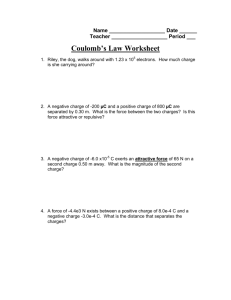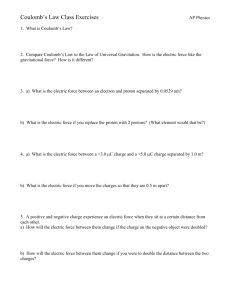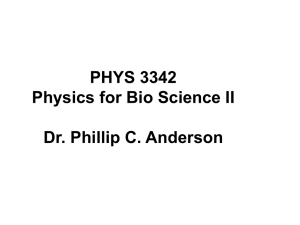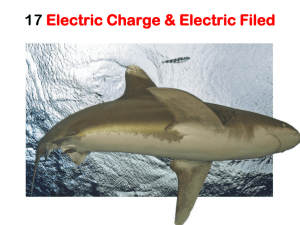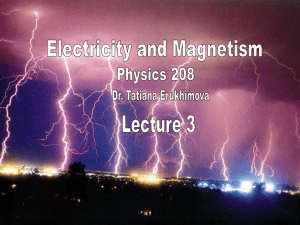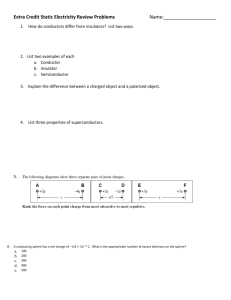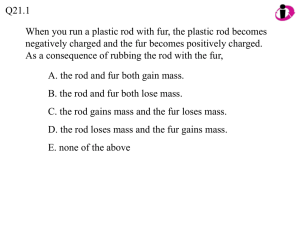Partial Solution Derivations for Capa #2
advertisement
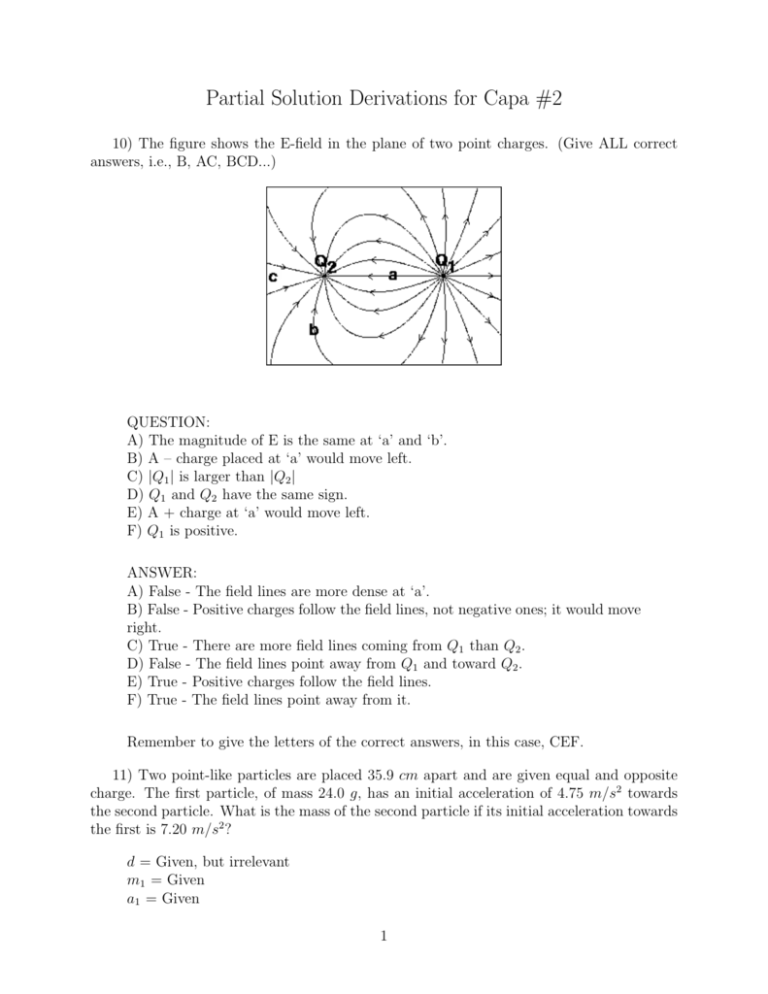
Partial Solution Derivations for Capa #2 10) The figure shows the E-field in the plane of two point charges. (Give ALL correct answers, i.e., B, AC, BCD...) QUESTION: A) The magnitude of E is the same at ‘a’ and ‘b’. B) A – charge placed at ‘a’ would move left. C) |Q1 | is larger than |Q2 | D) Q1 and Q2 have the same sign. E) A + charge at ‘a’ would move left. F) Q1 is positive. ANSWER: A) False - The field lines are more dense at ‘a’. B) False - Positive charges follow the field lines, not negative ones; it would move right. C) True - There are more field lines coming from Q1 than Q2 . D) False - The field lines point away from Q1 and toward Q2 . E) True - Positive charges follow the field lines. F) True - The field lines point away from it. Remember to give the letters of the correct answers, in this case, CEF. 11) Two point-like particles are placed 35.9 cm apart and are given equal and opposite charge. The first particle, of mass 24.0 g, has an initial acceleration of 4.75 m/s2 towards the second particle. What is the mass of the second particle if its initial acceleration towards the first is 7.20 m/s2 ? d = Given, but irrelevant m1 = Given a1 = Given 1 a2 = Given m2 = ? For this problem, use Newton’s third law: The force mass one exerts on mass two is equal and opposite to the force mass two exerts on mass one. Coulomb’s Law gives the force, but we do not need to calculate it. Newton’s second law says that F = ma. F12 = m1 a1 = m2 a2 Solve for m2 , m2 = m 1 a1 a2 12) What is the magnitude of the charge on each particle? For this problem, we do need the distance d given above and we have to calculate the force. But we actually already did. F12 = kq1 q2 = m 1 a1 r2 Since the two particles have equal and opposite charges, q1 = −q2 . We can drop the negative sign for mathematical purposes since the vector will handle the direction and think of the charges simply as q. The distance between the two charges is d. Substituting in, kq 2 = m 1 a1 d2 Solving for q, s 1 2 q= d m 1 a1 k BE CAREFUL inputting this expression. It took me 6 tries to input it into my calculator correctly. Make sure you are squaring the distance. 13) Four charges Aq, Bq, Cq, and Dq (q = 3.50 × 10−7 C) sit in a plane at the corners of a square whose sides have length d = 39.5 cm, as shown in the diagram below. A charge, Eq, is placed at the origin at the center of the square. DATA: A = 2, B = 8, C = 7, D = 8, E = −5. Consider the charge at the center of the square. What is the net force, in the x-direction, on this charge? For this problem, calculate the force that each surrounding charge has on the charge in the center. Since the sides of the square have length d, the distance that each surrounding charge is from the center is r= v ! u u d 2 t 2 d + 2 !2 = 2 v u u t d 2 2 !2 = √ d 2 2 To find the net force in the x direction, take each force you calculated and multiply by cos 45◦ . The y-direction would be obtained by multiplying the force by sin 45◦ . This is because the charges are arranged in a square of edge length d. 14) A charge Q = 1.90 × 10−4 C is distributed uniformly along a rod of length 2L, extending from y = −13.9 cm to y = +13.9 cm, as shown in the diagram above. A charge q = 8.40 × 10−6 C, and the same sign as Q, is placed at (D, 0), where D = 71.0 cm. Consider the situation as described above and the following statements. If the statement is true, answer ‘T’, if it is false, answer ‘F’, and if the answer cannot be determined from the information provided, answer ‘C’. For example, if ‘B’ and ‘C’ are true and there is not enough information to answer ‘D’ and the rest are false, then answer ‘FTTCF’. QUESTION: A) The net force on q in the y-direction does not equal zero. B) The magnitude of the force on the charge q due to the small segment dy is dF = (kqQ/2Lr2 ) dy C) The net force on q in the x-direction equals zero. D) The total force on q is generally in the → direction. E) The charge on a segment of the rod of infinitesimal length dy is given by dQ = (Q/L) dy ANSWER: A) False - The y-directional force on the charge q from the top half of the rod is cancelled by the y-directional force from the bottom half of the rod. B) True - To see this, use Coulomb’s Law: kqQ r2 It also works for small forces with small charges. F = kq dQ r2 If we want to sum all these charges up, we have to integrate over the length of the rod. Thus, we need a dy. dF = dQ is the charge on a small portion of the rod. The charge of the whole rod is Q Q and its length is 2L. The charge per unit length λ = 2L . So the charge on a length dy would be Q dQ = λdy = dy 2L Now, kqQ dF = dy. 2Lr2 C) False - The only force on q is in the x-direction. D) True - The force on q is in the x-direction. Q E) False - As computed above, dQ = 2L dy 3


